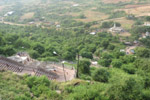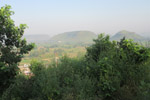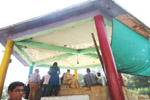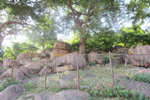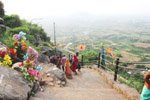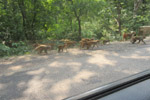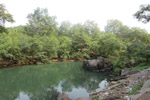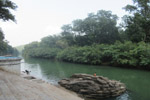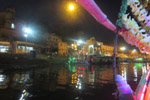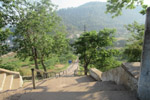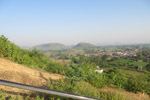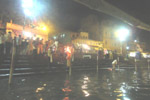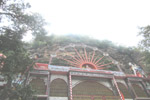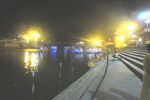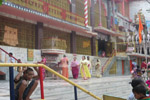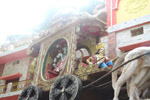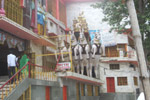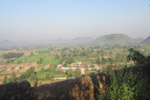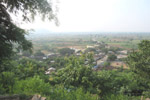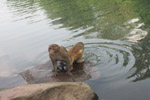Chitrakoot
‘Yavata Chitrakootasya narah sringanyavekshate । Kalyanani samadhatte na pape kurute manah ।। Rishayastatra bahavo vihritya sharadam shatam । Tapasa divamaroodhah kapalashirasa saha ।।’
When a person visits the mountains of Chitrakoot, (s)he attains fruits of good deeds and does not indulge in sins. There, many rishis, with hair as white as skull due to age, have moved on to heaven after hundreds of years of penance - This is how sage Bharadwaja describes Chitrakoot to Lord Ram in Ayodhyakanda of Valmiki Ramayana. It testifies to the long running spiritual relevance of this place.
Chitrakoot is located on the banks of River Mandakini, at the border of Uttar Pradesh and Madhya Pradesh. It is easily accessible by road. Nearest airport is in Prayagraj at approximately 110 km. The Chitrakootadham Karwi railway station is in Uttar Pradesh. It is covered under the special Ramayana Tour of Indian railways. Lodging options are plenty. The place lies at a distance of approximately 265 km from Ayodhya and 202 km from Brahmavart (Kanpur).
The name itself is a combination of Sanskrit words ‘Chitra’ meaning wonderful and ‘Koot’ meaning mountain, and situated in the ancient Vindhyachal range, it really is magnificent. It is also said that the place gets its name from the presence of the spotted deers called ‘Chitar’. As per a legend, Chitrakoot is said to have been established by Chitraksha, the son of Lord Chitragupta (Chittaur is also attributed to him), hence it got the name Chitrakoot.
The place has been favored since ancient times by tapasvis, gurus, seekers, etc. The greatest of sages – Anusuiyya, Atri, Valmiki, Markandey and others have resided in Chitrakoot. What mainly attracts scores of devotees here is its connection to Sri Ram. As per Valmiki Ramayana, Lord Ram along with Devi Sita and Lakshman ji chose this place, on the recommendation of sage Bhardwaja, to spend a considerable time of his exile. Ramcharitamanas mentions Sage Valmiki praising Chitrakoot and advising Sri Ram to stay there. It is here that He performed his father’s ‘shradha’, and gave his ‘paduka’ (footwear) to Bharat ji. And Sri Ram granted his vision to Tulasidas ji here. As goes the famous couplet-
‘Chitrakoot ke ghat par bhai santan ki bheer Tulasidas chandan ghisen tilak det Raghuveer’
There is a crowd of saints on river bank in Chitrakoot. Tulasidas is rubbing sandalwood that Sri Ram is applying on saints’ forehead. The most important spot is Kamad-giri, the mountain where Sri Ram resided. Circumambulation (of around 5 km) of this peak is very important. The entire path is well paved, shaded and dotted with various small temples. The residing deity Sri Ram is named here as ‘Kamatanath’ which means the wish-granting lord. Along the 5 km path is the place where Sri Ram and Bharat met, marked by the Bharat-milap temple.
Hanuman-dhara is a must visit. One has to climb a thousand steps to reach the temple. After having burnt down Lanka, Hanuman ji was still seething. As per Sri Ram’s guidance he came here and chanted the Ramaraksha stotra 1008 times, after which a water spring broke through the mountain and cooled Hanuman ji. The calmness of the atmosphere here is almost tangible. Further up the mountain is Sita-rasoi (kitchen).
Lakshman-pahari is where Lakshman ji sat on guard. It’s a steep climb, and ropeway facility has also been provided now.
Bharat-koop is also a significant place. When Bharat ji went looking for Sri Ram, he carried with him all the items needed for coronation so that Sri Ram could be crowned king of Ayodhya as soon as he met him. One of those items was water from all major rivers and seas of the Aryavarta. When Ram refused to be crowned, sage Vashishatha advised that this water be poured in a particular well. That place is called Bharat-koop. ‘Koop’ literally means well.
At some distance is Gupta-Godavari, a pair of caves with streams running through them. It is one of Chitrakoot’s central attractions. When a demon tried to peep on Devi Sita while she bathed, Lakshman ji stuck him to the roof of the cave with his arrow. So, one part of the cave’s roof is much darker than the rest of the surface.
Sati Anusuiyya ashram, placed near dense forest is a place oozing with serenity. The Mandakini river flows on earth due to Anusuiyya’s penance. Such was her ‘tapas’ that she transformed the trinity, Brahma-Vishnu-Mahesh, into infants.
Other spots bearing testament to Sri Ram’s residence in Chitrakoot are Janaki kund, Ramghat, Sphatik shila, etc. Aarti of Mandakini is mesmerizing. Boating services can also be availed. The place also has a lot to offer in terms of scenic beauty, especially during monsoon. Because of its stony topography, summer days are very hot here. For devotees of Sri Ram, pilgrimage to Chitrakoot is very important. It is advisable for seekers to stay here a few days and soak in the immense spiritual energy Chitrakoot is charged with, and experience the inner tranquility it offers.








